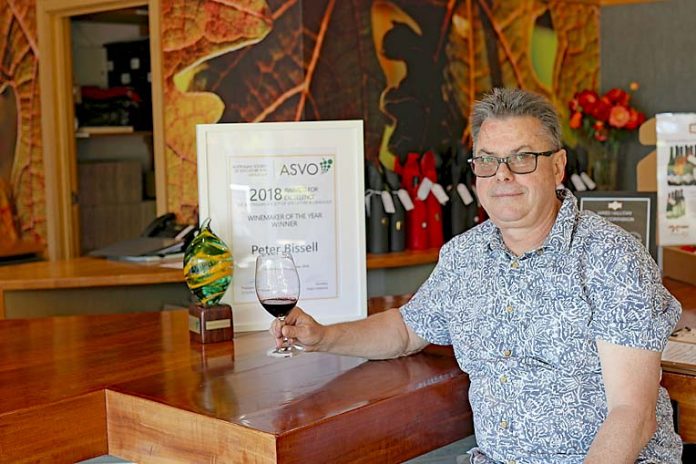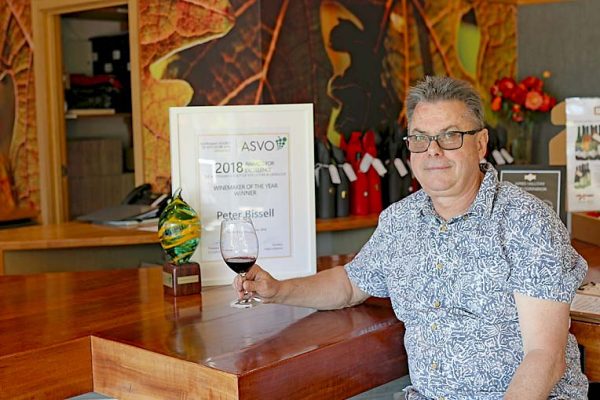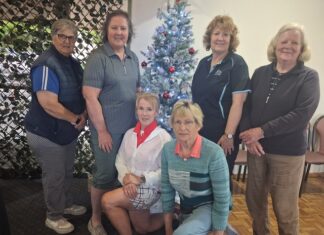

A JOURNEY to perfect the art of wine making has led Penola resident Pete Bissell into the spotlight as the 2018 Australian Society of Viticulture and Oenology winemaker of the year.
Mr Bissell was one of five major award recipients at the recent sold-out Awards of Excellence night which comprised individuals distinguished in the fields of viticulture and oenology and who demonstrate exceptional leadership ability and vision.
“They have put everything together from over the years and have gone ‘you are it’,” he said.
“It is really humbling and pleasing to receive recognition for the many years of hard work.”
With over 10 years spent at various universities, Mr Bissell was appointed Wynns winemaker in 1989, working at Wynns Coonawarra Estate with Peter Douglas.
In 1995 Mr Bissell moved to Balnaves of Coonawarra to design and oversee construction of the winery and take over winemaking where he has since received several accolades.
“At the time Balnaves was building its own winery and that was something that appealed to me deeply,” Mr Bissell said.
“At that stage no one I knew had the opportunity of becoming involved in something like that.”
Mr Bissell has completed vintages as a fly-in winemaker, visiting many parts of the world during his career.
“The nature of the wine industry is great because you can travel anywhere in the world and people will make wine.
“Wine people tend to be very friendly which is always fantastic.
“We often have international wine makers visit throughout our vintages as well.”
Several milestone innovations have occurred during Mr Bissell’s time at Balnaves.
In 2001, Balnaves was one of the first wineries to introduce screw caps across its Chardonnay range.
“The screw caps improve Chardonnay’s driving window and longevity,” Mr Bissell said.
“Our Chardonnay has won 12 trophies throughout the Limestone Coast Wine Show which includes Best Chardonnay eight times and Best White Wine four times.”
In 2003/04, the winery adopted the Australian invention Pro-Cork for reds after investigating trial work.
“The cork has multi-layer membrane on either end to prevent Trichloroanisole contamination, flavour scalping and variable O2 transfer,” Mr Bissell said.
“We began using Pro-cork on our top wine The Tally Reserve Cabernet Sauvignon in 2005 and are continuing to use this closure.
“With natural cork, one of the problems is they are all different so they transfer different amounts of oxygen into the wine.”
In 2004 the winery adopted the use of alternative yeasts, particularly AWRI 1375 in Chardonnay.
“It is a really interesting and unusual yeast that adds complexity and texture to the wine,” Mr Bissell said.
“This yeast is now named Saccharomyces uvarum and we continue to source it from agar slopes each vintage.”
Throughout 2012 berry sorting technology was trialled with Pellenc winery equipment to help remove gum leaves and materials other than grapes from processing.
“The logistics of slowing down production flow to sort at the winery is not advantageous when significant volumes of fruit are involved,” Mr Bissell said.
“Balnaves of Coonawarra viticulturist Pete Balnaves and I developed berry sorting conveyors that sit off trailers above the picking bins, allowing for constant picking.
“The first prototype was trialled in 2013 and we now have had six units operating since 2016 completely built by Balnaves.”
The first commercial built harvesting prototype has been trialled this year.
“We have been undergoing trials to see what works and what does not,” Mr Bissell said.
“This is something unique that we have completely done ourselves.”
Since 2015 Balnaves has also conducted trials to measure the total antioxidants in red wines.
“These trials measure the potential longevity of the wines,” Mr Bissell said.
“Our final aim is to determine which of our wines have the best long term potential and whether we can prevent deterioration of colour and flavour.”
The winery has planted the first material available in South Australia from Yalumbas ENTAV clones with two of Cabernet Sauvignon and one of Merlot.
“It is very interesting to compare this to the best selected material from current vineyards in France given the original material in Australia largely came from France,” Mr Bissell said.
“We have released three bottles of wine utilising the first material from Yalumbas ENTAV clones of Cabernet Sauvignon and Merlot.
“The wine is sold as a fresh youthful wine, bottled at six months with minimal oaking to allow consumers and other winemakers to appreciate the flavour and tannin qualities of these new clones.”
Mr Bissell also played a lead hand in developing a map of sub-regions within Coonawarra.
“This lead to the production of the Coonawarra sub-region map throughout consultation with other winemakers,” Mr Bissell said.
“The map was published by Balnaves online and recently in Patrick Iland’s Australian Wine 2017 edition.
“The map is designed to help tasters understand some of the diverse difference in Coonawarra wines.”
Mr Bissell is the lead author in the Red Winemaking chapter of Australian Winemaking by Eds V. Jiranek and N Bulleid working together with Stephen Henschke, Corey Ryan, Fiona Donald and Nick Bulleid.
“The is project has taken over 10 years to pull together for online publication in 2013 with people publishing different chapters,” Mr Bissell said.
“It is about giving a discussion as not everyone may agree with the map.
“We are trying to communicate to the next generation of wine makers.”
Mr Bissell was a foundation member of the Limestone Coast Wine Show set up in 2001 and was a judge coordinator.
“The show brings leading wine judges from around the world and educates them about the Limestone Coast,” he said.
“It has allowed me to talk to the wider industry about phenolic, texture and wine styles.”
He has also been chair of the Limestone Coast Grape and Wine Council which has hosted the wine show for the last decade.
Despite all his experience across a broad sector, Mr Bissell said every vintage remained different.
“We are constantly challenged to tweak things,” he said.
“We have to work out what is happening to try and make the best wine we can.”
Mr Bissell has enjoyed his wine making career and the lifestyle it brings.
“It is really nice to make something that people put in their cellars and keep for years,” he said.
“They then pull it out on special occasions and that gives me a lot of satisfaction.
“If it is a good bottle, it adds to a lot of what are people’s most happiest occasions.”





